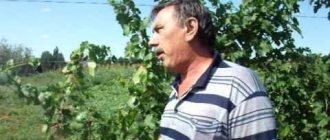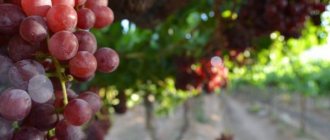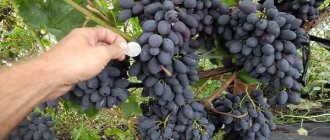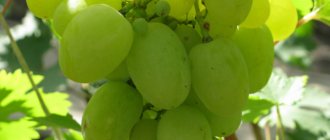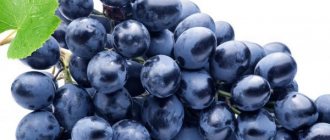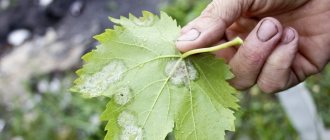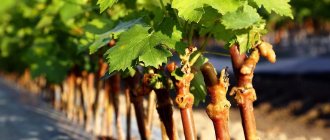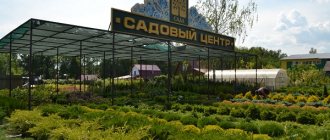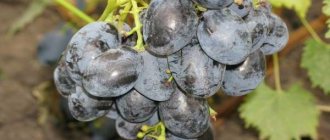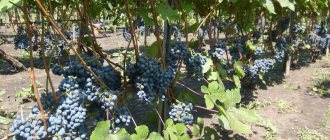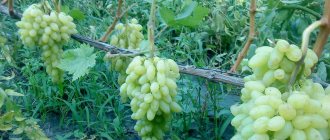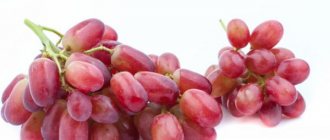Loading... Do you need a versatile early grape variety with large berries? Plant the Long-awaited grapes, the description of the variety (photo) of which we will consider in detail today. This is one of the young hybrids. His parents are Radiant Kishmish and Talisman. Although it was recently introduced, it has already become popular due to its high taste characteristics and unpretentiousness. Large and juicy berries can be used not only for food, but also for making wine.
Advantages and disadvantages
The “long-awaited” grape has many advantages, thanks to which the variety is grown not only in summer cottages, but also on an industrial scale, namely:
- Very early ripening.
- High yield, up to 10 kilograms of berries are harvested from one vine.
- The harvest begins already in the third year after planting;
- Excellent taste and presentation.
- Long-term storage of grapes and good transportability.
- The presence of bisexual flowers promotes self-pollination.
A significant disadvantage of the variety is the susceptibility of berries to damage during heavy, prolonged rains at the end of the growing season. The grapes crack and fall off. This crop is poorly stored.
History of growing the Long-awaited grape variety
The history of the Long-awaited is relatively short: it appeared already in the current millennium thanks to the efforts of the amateur breeder V.N. Krainov. It sometimes happens that great science is done not only in serious laboratories, but also practically “in the kitchen.” Viktor Nikolaevich Krainov, who lived in Novocherkassk, was called a “private” breeder. He created beautiful hybrid forms of grapes without working in any serious research institutes.
As the enthusiast himself said in one of his last interviews, he has been involved in viticulture since he was 15 years old, since 1953, and his father, a retired colonel, instilled this passion in him. And since 1986, V.N. Krainov was seriously engaged in selection on a summer cottage located on the banks of the Tuzla River.
And it was in conditions of a not very favorable climate (coastal fogs, morning dew, frequent frosts) that he developed his wonderful varieties. In total, he bred more than 40 grape varieties, and about half became well known and widespread.
The berries and clusters of varieties from V.N. Krainov’s collection are called “solid, impressive, gigantic, gigantic.” The varieties he bred have occupied a worthy place in the vineyards of our country for 20 years. The first hybrid to become known in 1998 was called NiZina. Then the number of varieties grew rapidly, although they were all bred in different ways from just a few well-known forms. And most of his developments receive only positive reviews.
NiZina is the first grape from V. N. Krainov’s collection to be released to the public
The Long-awaited grapes were obtained by hybridization of the Kishmish Radiant and Talisman varieties, the main advantage of which is the excellent taste of the berries. Thus, Talisman is recommended for cultivation in many regions of our country, since it ripens well even in short summer conditions and is resistant to any vagaries of weather. Kishmish radiata is a seedless grape that has a subtle muscat aroma and a unique taste .
Kishmish Radiant - one of the parents of the Long-awaited - produces large berries, but without seeds
Having taken all the best from its parents, the Long-awaited grape is a table variety. Its berries are transparent white to amber in color and are characterized by a harmonious taste. The variety is famous for its solid yields, very early ripening and high frost resistance, which allows it to be grown even in harsh regions. Long-awaited is an excellent variety of table grapes for homestead and country viticulture.
Origin
The young hybrid “long-awaited” was bred by amateur breeder V.N. Krainov. For crossing, he took the famous grape varieties “Kishmish Radiant” and “Talisman”. The result is a new hybrid variety with excellent berry taste. Winegrowers have long dreamed of such a tasty, high-yielding, frost-resistant variety, so the new variety was called “the long-awaited one.”
Parents of the “long-awaited” one – “radiant sultana” and “talisman”
Harvest and storage
We recommend reading our other articles
- Fittonia flower
- Flower pots
- Technology for growing winter wheat
- The best breeds of geese
Clusters of berries ripen around mid-August. After the berries are ripe, it is advisable to collect the bunches immediately, since if they become overripe, the presentation will begin to deteriorate.
Important!
If it rains a few days before harvest, the berries may crack and begin to fall off. This usually leads to a deterioration in transportability and marketability. At the same time, in dry weather, the concentration of sugar in the berries may increase and this will attract the attention of wasps and similar insects.
Harvested grapes can be stored without problems if they are healthy, which is why the variety is often grown for sale. The collected bunches can be used for fresh consumption, making desserts, juice, jam and other dishes.
Main characteristics
“Long-awaited” attracts with its taste, early ripening, and presentable appearance.
Ripening period
The hybrid belongs to the early ripening varieties. The growing season is only 105 – 120 days. Already in mid-August, the ripe clusters begin to be collected. It is also worth noting that early varieties include “furor”, “delight”, “early gourmet” and several other promising varieties of white and pink grapes. Black grapes are never early.
Bush
The grape bushes are medium-sized, spreading. The vines are powerful and ripen well. The bush grows quickly in all directions. Typically, a bush of this variety is formed into four branches.
Bunches and berries
The variety has large, symmetrical, conical brushes with an average weight of 700–800 grams. With proper agricultural technology, the weight of one bunch reaches 1500 grams.
Reference! In different seasons, the same vine may produce berries with or without seeds.
Grapes of the “long-awaited” variety have an elegant elongated shape and slightly narrowed towards the tip, the weight of one berry is 10 - 12 grams. The greenish-white berries acquire an amber transparency when fully ripe.
Juicy, fleshy, elastic, crispy flesh is covered with a thin, dense skin that is not felt when eating. The berries contain soft rudimentary seeds or 1-2 hard ones.
It is possible for some of the berries to pea, but they also ripen. Ripe berries contain up to 22% sugar.
Taste
The rich, delicate taste of the berries harmoniously combines sweetness and slight sourness, leaving no tart aftertaste.
Description of the grape variety Long-awaited
The long-awaited one grows in the form of a rather large bush, which requires a lot of space. But at the same time, it cannot be considered a giant, and when planting several bushes, a distance of 1.5–2 meters between them is sufficient. At this distance, the bushes are intertwined with roots, but do not interfere with each other at all. Actually, they don’t need mutual help either: the flowers of the variety are bisexual, therefore, if a large number of berries are not required, for example, for sale, one plant on the plot is quite enough.
The long-awaited one can be grafted onto bushes of other varieties and itself, in turn, is a good rootstock, which is often used in practice to increase the assortment of grapes in small areas.
It is easily propagated by cuttings: their rooting rate is characterized by specialists as very high. The bush grows quite quickly in all directions, regardless of its origin: grown from its own cuttings or grafted onto another seedling.
The vine ripens well, the shoots manage to become woody almost to the tops, even in short summer conditions. Frost resistance of the bush is down to -23° C. The resistance of the variety to fungal diseases is estimated at 3.5 points: there is a high probability of oidium disease. At the same time, Long-awaited is immune against ticks. It begins to produce good yields within 3 years after planting, which is one of the undoubted advantages in both industrial and amateur gardening.
Wasps rarely eat berries. The long-awaited one, for unknown reasons, is not very attractive to these striped pests.
The variety is recommended for cultivation in northern regions, since it does not require a lot of sunlight for active growth and full ripening.
The bush can withstand a load of 20–25 shoots. The long-awaited one belongs to the varieties of ultra-early ripening: from the beginning of the growing season to the full ripening of the berries it takes from 105 to 120 days. Flowering begins in mid-June. Since the flowers are bisexual, there is no risk of incomplete pollination resulting in very small berries. Already in early August you can pick very tasty and juicy berries. It cannot be said that the yields of the variety are huge, but they are stable, and up to 10 kg of berries can be obtained from a bush.
The clusters of the Dolgozhdanny grape variety are cone-shaped and very large: on average about 800 g, but sometimes they grow up to 1.5 kg. It is gratifying that they reach their maximum size already in the second year after the start of fruiting. However, the bunches are not very dense, rather medium-loose: the berries do not “stick” to each other. Their transportability is characterized as very high.
The berries are not very densely packed into the bunch, but their total mass is very solid
The grapes have a characteristic oblong-pipillate shape, are very beautiful, their color is considered white. However, fully ripe berries acquire an amber tint and almost perfect transparency in transmitted light. The berries are very large, weighing 10–12 g, up to 3.5 cm long. The skin is of medium density, neutral, and cannot be felt when eating the berries. The pulp is fleshy, elastic, pleasant taste. The flavor bouquet is harmonious, rich, sweet and sour. The sugar content of the berries is about 20%, the acidity is up to 8 g/l. Astringency is characterized as insignificant. Taste quality on a 5-point scale by professional tasters is rated at 4.5 points.
The berries are mostly seedless, but some contain 1–2 dense, medium-sized seeds.
It is impossible to visually distinguish berries with and without seeds, and both are found on every bunch.
The safety of the berries both on the bush and those already collected is high. Ripe berries do not crack. Only prolonged heavy rains can ruin their presentation. Oversaturated with water, the berries burst and rot, and are also easily torn from the brush. The variety is quite transportable. The Long-awaited grapes are suitable for fresh consumption and for winemaking: the combination of sugar content, acidity and harmonious taste is quite conducive to the universal use of the crop.
Video: Long-awaited grape harvest in the garden
Comparison with analogues
Let’s compare the “long-awaited” one with its main seedless competitors.
| Sign | Variety | |||
| Long awaited | Century | Veles | Kishmish Radiant | |
| Ripening period | 110-120 days | 110-120 days | 100 - 110 days | 125 – 130 days |
| Frost resistance | Up to -23 °C | Up to -23 °C | Up to -23C | Up to -22C |
| Yield per bush | 10-12 kg | 30-40 kg | 30-50 kg | 20 – 30 kg |
| Bunches | 700-800 g | up to 1.5 kg | 600 g – 2 kg | Up to 1 kg |
| Taste | Harmonious | Moderately sweet and mild | Muscat | Nutmeg flavor |
| Color | Green-yellow | Green-yellow | Pink - amber | Hot pink |
| Disease resistance | Average | Average | Above average | Above average |
| Shelf life | Several months | Few weeks | Up to 3 months | 1 month |
| Sugar content | 19-22% | 13-14% | 17 – 22% | 17-21% |
| Acidity | 5-9 g/l | 5-7 g/l | 5 - 7 g/l | 6.5-7.5 g/l |
Characteristics of the Long-awaited grape variety
Having become acquainted with the table grapes of the Dolgozhdanny variety, we can draw some conclusions by summing up the main advantages and disadvantages of this hybrid. Actually, there are practically no shortcomings described. And both the plant itself and its fruits have advantages: large clusters of very tasty berries. The main advantages of the variety are as follows:
Recent Entries
5 working ways to use tar in the garden 7 indoor plants that help you get married even in adulthood Indoor plants that can bloom in trouble
- very early maturation;
- bisexuality of flowers;
- large size of the bunch and each berry;
- magnificent appearance;
- high transportability of the crop and shelf life;
- harmonious taste and thin, invisible skin;
- the almost complete absence of seeds, which makes it possible to classify the variety almost as sultanas;
- stable yield;
- low susceptibility to wasps;
- high frost resistance;
- full ripening of shoots;
- compatibility with any rootstocks and scions;
- good rooting of cuttings.
Relative disadvantages of the variety:
- average resistance to most diseases;
- instability of the ripened crop to prolonged rains;
- incomplete seedlessness.
Features of cultivation
Proper care ensures a stable “long-awaited” grape harvest. The hybrid is grown from cuttings, seedlings or grafting.
Landing
“Long-awaited” is planted at the end of April. In the southern regions, it can be planted in October, providing the young seedlings are well covered for the winter.
Reference! Before planting, it is recommended to dip the roots of the seedlings in a mixture of mullein, clay and water with the consistency of liquid sour cream.
Place and soil
For planting grapes, choose sunny, warm areas, protected from cold northern winds. Planted near the wall of a house, a high fence, next to trees that will provide protection from wind and drafts. The ideal place for landing is written in a separate article.
For full development of the variety, light, loose soil is required. If the soil is clayey, then it is mixed with sand and brick chips. Humus is added to sandy soils. It is necessary to avoid areas with close groundwater.
Watering and fertilizing
“Long-awaited” does not like waterlogging, so it is rarely watered. Abundant watering is carried out only after planting and during the ripening period of the berries.
After the last frost in the spring, the grapes are fed with humus or manure.
At the beginning of summer, 1-2 liter jars of wood ash are added under the bush; it strengthens the root system. Before and after flowering, foliar feeding is carried out by spraying with complex fertilizers. After harvesting, fertilizers containing phosphorus are applied.
Important! Fertilizers applied during berry ripening should not contain nitrogen.
Trimming
In the fall, long pruning of the bush is carried out, leaving 8 - 10 buds on each of 20 - 25 shoots. In spring, damaged shoots are removed.
In the summer, pinching is carried out regularly, preventing the bush from thickening so that the sun has access to the berries. Some leaves are removed, which promotes ventilation and eliminates fungal diseases.
Harvest of correctly pruned “long-awaited”
It is necessary to pick ripe bunches in time so that the branches do not break under the weight of the harvest.
Diseases and pests
The “long-awaited” hybrid has average sensitivity to fungal diseases, is resistant to mildew, but is susceptible to oidium. For prevention, the plant is treated with fungicides several times a season. “Long-awaited” is resistant to infection by grape mites and is rarely attacked by wasps and birds.
Shelter for the winter
“Long-awaited” can withstand cold temperatures down to -23 degrees. Even when the buds freeze, the shoots produce a harvest, but one month later.
Important! The hybrid must be covered for the winter in areas with cold winters. Annual shoots are covered regardless of weather conditions.
In the autumn, after leaf fall, the vines are treated with a 3% solution of iron or copper sulfate to protect the plant from fungus, mold and rot, the bushes are hilled up and removed from their supports. The vines are tied into bunches and laid on the ground or flooring, sprinkled with earth, dry leaves, pine spruce branches or sawdust. It is recommended to cover the top with agrofibre to prevent the grapes from getting wet. More details on how to properly cover grapes for the winter can be found in a separate article.
Harvest storage
The “long-awaited” bunches are stored for a long time in cellars and storerooms at temperatures from 0 to +7 degrees. In the refrigerator at a temperature of -1 to +2 degrees, the crop is stored for 4 - 7 months.
Regions
The “long-awaited” grape variety has become widespread throughout almost the entire country. It is grown in the south, in the regions of Central Russia. Can be grown in northern regions with denser shelter for the winter.
Diseases and pests
The Long-awaited variety is included in the 10 best forms (varieties) from year to year. Grape growers value it for its resistance to mildew and grape mites. In relation to oidium pathogens, immunity is average. It is increased using a set of preventive measures:
- In early spring, they inspect the bushes, cut out dry shoots, and burn them;
- In the spring, the vine is sprayed with contact fungicide "Azofos", it contains copper, add 1 tbsp to 10 liters of water. facilities;
- They use finely ground sulfur, they pollinate the bushes with it in the morning (evening), and they also cultivate the soil in the root zone;
- in the fall, the shoots are sprayed with a 3% solution of vitriol (copper, iron).
Reviews
The Long-awaited bunch contains berries both with seeds (large) and without seeds, you never know whether you will get seeds in the berry or not. Irina, Novocherkassk
The long-awaited taste is harmonious, the skin is not felt when eating. The variety is not subject to peas, the berries are transparent white. Sergey Vasiliev, Gelendzhik
I cut my Long-awaited one by 6-7 buds. The ripening of the vine is good, the growth vigor is above average, the seedlings have taken root well, and there have been no diseases. Oleg, Khorol
Care
Proper care allows you to get a stable and rich harvest of berries. When growing this variety, you should pay attention to the following points:
- despite high frost resistance , after harvesting in the fall it is necessary to remove the bush from the trellis and cover it for the winter;
- It is required to carry out regular preventive treatments against diseases and pests. Due to the high sugar content in the berries, wasps often appear on the fruits, so it is necessary to protect the bunches;
- Regularly need to carry out long pruning so that on one bush there are no more than 33 eyes on a total of 22-24 shoots;
- It is necessary to apply mineral and complex fertilizers to enhance growth and achieve high yields.
Even at the time of planting, it is necessary to consider an underground drainage irrigation system in order to protect the bush from drought and waterlogging. This method of adding water is optimal for all grape varieties.
It is recommended to cover the bushes with film from the rain and not to flood the plantings.
Disease Prevention
The variety has an average level of resistance to diseases and pests. To avoid infection, you need to regularly remove excess foliage, since it is this that is susceptible to infection. The bush has high resistance to mildew, as well as almost complete immunity against mites. If agricultural practices are not followed, infection with oidium may occur. When the first signs of grape diseases appear, it is important to completely treat the planting with a systemic or contact fungicide or insecticide.
Trimming
Like the Preobrazhenie and Libya varieties, the Long-awaited grapes require constant pruning. As a rule, the procedure is carried out in spring or autumn. Long pruning is recommended, approximately 8-10 buds. Due to the tendency to certain diseases after the procedure, the cut site must be treated, and a sharp and clean instrument must be used.
Advantages and disadvantages
The Long-awaited grape is considered the best among its analogues. The taste of its berries is inferior, for example, to the super early Tason; it ripens later than Libya, but it is an almost seedless variety. The list of advantages of the Long-awaited is impressive:
- very early maturation;
- does not require pollinators;
- large fruit;
- excellent presentation;
- long storage and transportability;
- there are rarely seeds;
- high productivity;
- winter hardiness;
- excellent ripening of young shoots;
- immunity against wasps
The disadvantages are considered:
- average level of disease resistance;
- spoilage of berries in rainy weather;
- incomplete absence of seeds, which is why the variety can conditionally be considered sultana.
Gardeners place the long-awaited raisin grape in the top ten ranking of early table varieties. The statement is not indisputable, but based on the totality of its advantages and growing popularity, it can be argued that this is a worthy extra-early variety.
